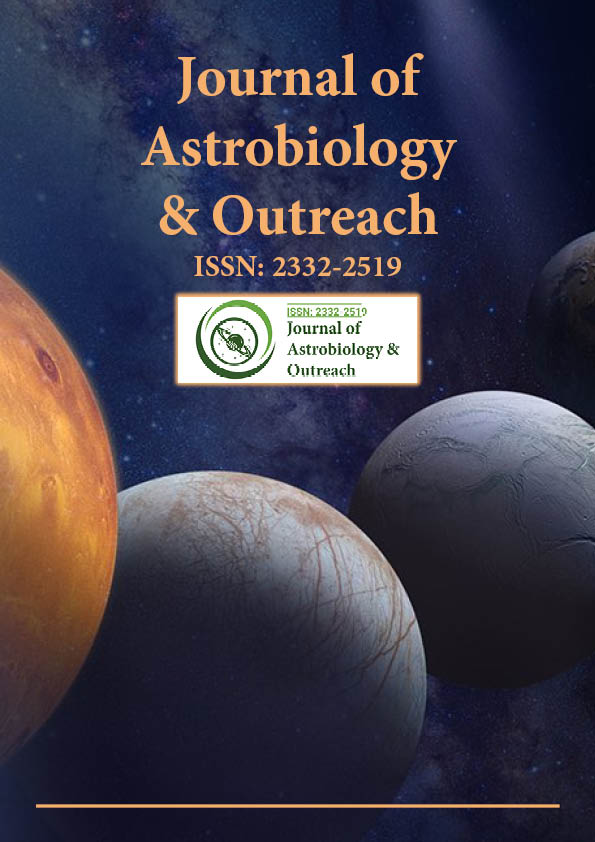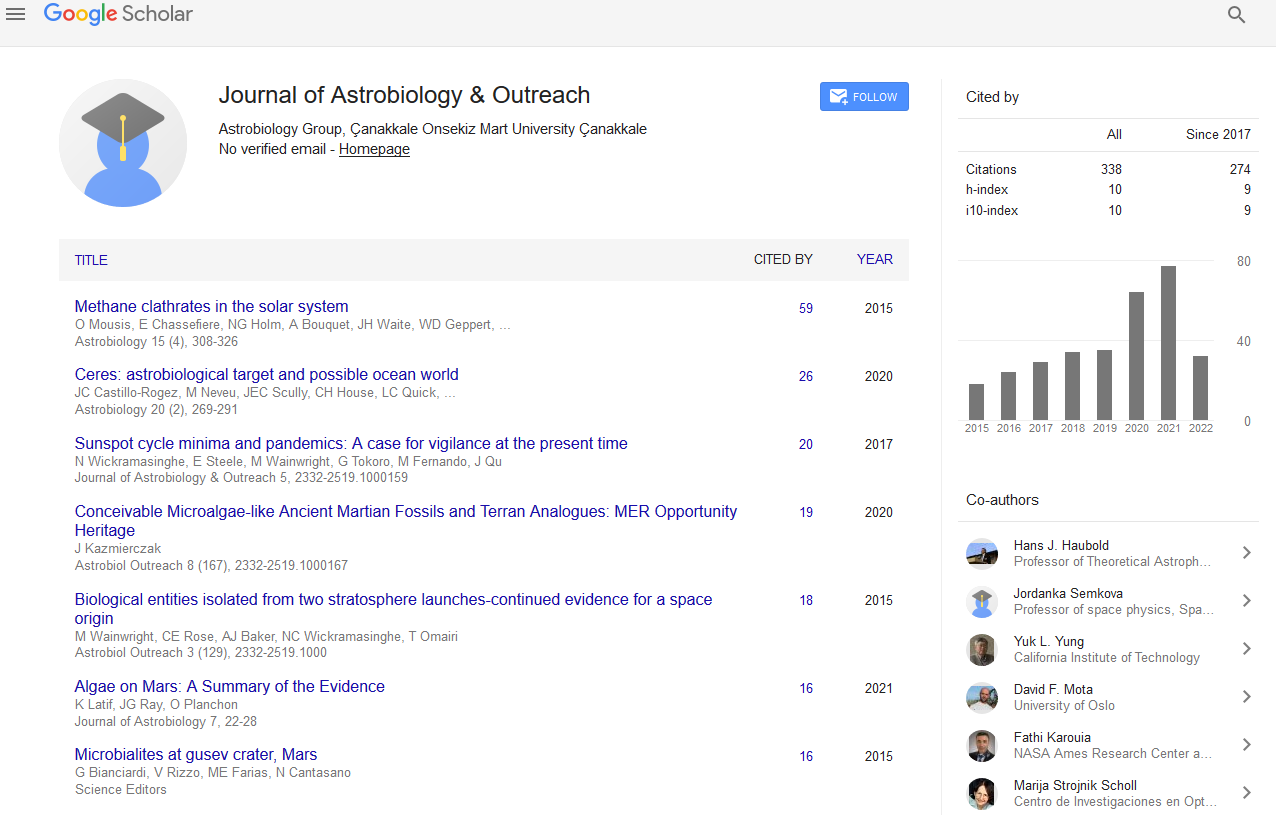Indexed In
- Open J Gate
- Academic Keys
- JournalTOCs
- RefSeek
- Hamdard University
- EBSCO A-Z
- OCLC- WorldCat
- Google Scholar
Useful Links
Share This Page
Journal Flyer

Open Access Journals
- Agri and Aquaculture
- Biochemistry
- Bioinformatics & Systems Biology
- Business & Management
- Chemistry
- Clinical Sciences
- Engineering
- Food & Nutrition
- General Science
- Genetics & Molecular Biology
- Immunology & Microbiology
- Medical Sciences
- Neuroscience & Psychology
- Nursing & Health Care
- Pharmaceutical Sciences
Perspective - (2023) Volume 11, Issue 1
The Sterilization Techniques' Effects on Research Involving Mars Sample Return (MSR)
Walton Hard*Received: 02-Jan-2023, Manuscript No. JAO-23-20227; Editor assigned: 05-Jan-2023, Pre QC No. JAO-23-20227 (PQ); Reviewed: 20-Jan-2023, QC No. JAO-23-20227; Revised: 25-Jan-2023, Manuscript No. JAO-23-20227(R); Published: 03-Feb-2023, DOI: 10.35248/2332-2519.23.11.281
Description
In order to determine whether there was life on Mars where and when environmental circumstances permitted, the NASA/ESA Mars Sample Return (MSR) Program is being conducted. Laboratory analyses of the samples that have been returned are helpful if the results show evidence of Martian phenomena rather than the results of sterilising conditions [1]. This study proves that some measurement types can still be useful even after sample sterilisation, but other types cannot. By rupturing chemical bonds, sterilisation destroys living microbes and inactivates intricate biological structures. Sterilization has similar effects on chemical bonds in nonbiological molecules, such as hydrous minerals, hydrous amorphous solids, and abiotic or pre-biotic reduced carbon compounds. We took into account both the sterilising effects of -irradiation and the sterilising effects of applying dry heat under two distinct temperature-time regimes [2].
Many volatile-rich material measurements are sterilisation sensitive they will be ruined by radiolysis or dehydration during the sterilisation process. Dry-heat sterilisation and γ-irradiation differ somewhat in their effects but affect the same chemical components. The abundances, oxidation-reduction (redox) states, and isotope abundances and ratios of most redox-sensitive elements are among the sterilization-sensitive measures. At least one redox-sensitive element is present in every biological molecule, as well as the majority of minerals and naturally occurring amorphous materials that developed under livable conditions. So, if the samples obtained by Mars 2020 rover Perseverance cannot be examined in an unsterile environment, sterilization-sensitive evidence about early life on Mars and its relationship to its ancient environment will be seriously jeopardised [3].
Contingency instruments in addition to those needed for curation, time-sensitive science, and the Sample Safety Assessment Protocol would need to be added to the Sample Receiving Facility (SRF) in order to guarantee that sterilizationsensitive measurements can be made even on samples deemed unsafe for unsterilized release from containment. To fill knowledge gaps about the effects of sterilisation on crucial scientific measurements, targeted investigations using analogues of MSR Campaign-relevant returned-sample types should be carried out, especially if the sterilisation regimens ultimately chosen are different from those considered in this report. The NASA/ESA Mars Sample Return Campaign's top aim is to determine whether life exists on Mars, or if it did, where and when paleoenvironmental circumstances permitted it to. It would be necessary to measure a wide range of qualities and traits using several, various instruments in order to provide answers to these queries from studies of the returned samples [4]. Unsterilized subsamples may not be able to be securely released to terrestrial laboratories that do not operate at Biosafety Level 4 (BSL 4), depending on Planetary Protection standards. As a result, it's important to ascertain whether sterilisation has any unfavourable effects on sample integrity, particularly the accuracy of the subsample attributes that need to be assessed. Measurements on unsterilized subsamples should be supported by the Sample Receiving Facility (SRF) for sample attributes that do not survive sterilisation intact. In this study, the impact of subsample sterilisation on the MSR Campaign's scientific objectives is examined. It evaluates how the effects of sterilisation affect the subsamples' scientific utility and, consequently, our capacity to carry out superior scientific research [5].
References
- Williams RM, Irwin III RP, Zimbelman JR. Evaluation of paleohydrologic models for terrestrial inverted channels: Implications for application to martian sinuous ridges. Geomorphology. 2009;107: 300-315.
- Skulinova M, Lefebvre C, Sobron P, Eshelman E, Daly M, Gravel JF, et, al. Time-resolved stand-off UV-Raman spectroscopy for planetary exploration. Planetary and Space Science. 2014; 92:88-100.
- Sharma SK, Misra AK, Lucey PG, Wiens RC, Clegg SM. Combined remote LIBS and Raman spectroscopy at 8.6 m of sulfur-containing minerals, and minerals coated with hematite or covered with basaltic dust. Spectrochim Acta A Mol Biomol Spectrosc. 2007; 68(4):1036-1045.
[Crossref] [Google Scholar] [PubMed]
- Sekiya T, Ohta S, Kamei S, Hanakawa M, Kurita S. Raman spectroscopy and phase transition of anatase TiO2 under high pressure. J. Phys. Chem. Solids. 2001; 62(4):717-721.
- Pilles EA, Cross M, Caudill CM, Francis R, Osinski GR, Newman J, et, al. Exploring new models for improving planetary rover operations efficiency through the 2016 CanMars Mars Sample Return (MSR) analogue deployment. Planet. Space Sci. 2019;165:250-259.
Citation: Hard W (2023) The Sterilization Techniques' Effects on Research Involving Mars Sample Return (MSR).11:281.
Copyright: © 2023 Hard W. This is an open-access article distributed under the terms of the Creative Commons Attribution License, which permits unrestricted use, distribution, and reproduction in any medium, provided the original author and source are credited.

